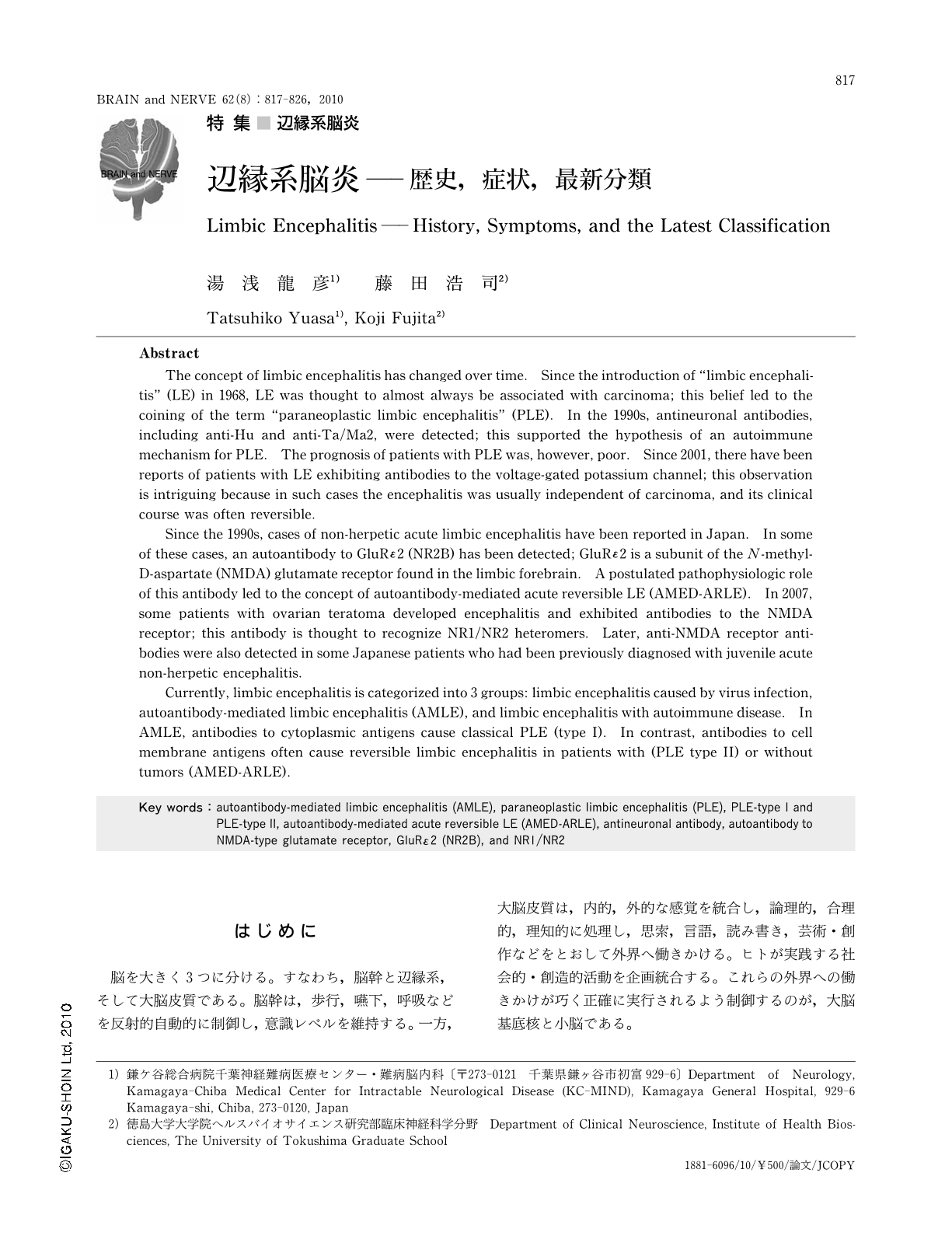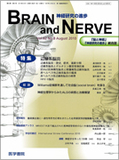Japanese
English
- 有料閲覧
- Abstract 文献概要
- 1ページ目 Look Inside
- 参考文献 Reference
はじめに
脳を大きく3つに分ける。すなわち,脳幹と辺縁系,そして大脳皮質である。脳幹は,歩行,嚥下,呼吸などを反射的自動的に制御し,意識レベルを維持する。一方,大脳皮質は,内的,外的な感覚を統合し,論理的,合理的,理知的に処理し,思索,言語,読み書き,芸術・創作などをとおして外界へ働きかける。ヒトが実践する社会的・創造的活動を企画統合する。これらの外界への働きかけが巧く正確に実行されるよう制御するのが,大脳基底核と小脳である。
これらに対して辺縁系は,脳幹と大脳皮質の中間に位置し,記憶,情動,自律神経系など生存に関わる機能を制御する。第一義的には情動と記憶を管理し,さらには大脳皮質を制御する。つまり,基本的には五感から得た情報や快・不快などの情動を統合し,同時に,それに基づき大脳皮質の機能を調節し,生存や種の継続に直結する行動を管理する。
すなわち,生物の進化の過程をとおして生存を保障する仕組みといってよく,匂いや触覚の記憶,捕獲行動,逃避行動などに始まり,快・不快の情動,摂食,性行動,ホルモン調節機能などに関わる。より高等な感情としては,愛情,悲哀,嫉妬,怒り,思いやり,共感などを制御する。
辺縁系の働きは極めて多岐にわたるが,辺縁系の役割を意識する機会は少ない。しかし,いったん辺縁系が疾患におかされるとき,われわれは改めて辺縁系の働きがいかなるものであるのかを認識する。
本稿ではこうした辺縁系の機能に焦点を当てて,辺縁系脳炎の臨床研究に関する今日の到達点を解説する。
Abstract
The concept of limbic encephalitis has changed over time. Since the introduction of "limbic encephalitis" (LE) in 1968, LE was thought to almost always be associated with carcinoma; this belief led to the coining of the term "paraneoplastic limbic encephalitis" (PLE). In the 1990s, antineuronal antibodies, including anti-Hu and anti-Ta/Ma2, were detected; this supported the hypothesis of an autoimmune mechanism for PLE. The prognosis of patients with PLE was, however, poor. Since 2001, there have been reports of patients with LE exhibiting antibodies to the voltage-gated potassium channel; this observation is intriguing because in such cases the encephalitis was usually independent of carcinoma, and its clinical course was often reversible.
Since the 1990s, cases of non-herpetic acute limbic encephalitis have been reported in Japan. In some of these cases, an autoantibody to GluRε2 (NR2B) has been detected; GluRε2 is a subunit of the N-methyl-D-aspartate (NMDA) glutamate receptor found in the limbic forebrain. A postulated pathophysiologic role of this antibody led to the concept of autoantibody-mediated acute reversible LE (AMED-ARLE). In 2007, some patients with ovarian teratoma developed encephalitis and exhibited antibodies to the NMDA receptor; this antibody is thought to recognize NR1/NR2 heteromers. Later, anti-NMDA receptor antibodies were also detected in some Japanese patients who had been previously diagnosed with juvenile acute non-herpetic encephalitis.
Currently,limbic encephalitis is categorized into 3 groups: limbic encephalitis caused by virus infection,autoantibody-mediated limbic encephalitis (AMLE),and limbic encephalitis with autoimmune disease. In AMLE,antibodies to cytoplasmic antigens cause classical PLE (type I). In contrast,antibodies to cell membrane antigens often cause reversible limbic encephalitis in patients with (PLE type II) or without tumors (AMED-ARLE).

Copyright © 2010, Igaku-Shoin Ltd. All rights reserved.


